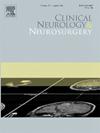西北地区老年人癫痫的临床特点及治疗反应
IF 1.8
4区 医学
Q3 CLINICAL NEUROLOGY
引用次数: 0
摘要
目的探讨老年癫痫的临床特点及治疗效果。方法选取2019 - 2022年西北地区三级医疗中心收治的连续癫痫患者(年龄≥65岁),分为早发性癫痫(EOE)组和晚发性癫痫(LOE)组。回顾性分析临床资料,随访1年。结果共纳入老年PWE 239例(EOE组100例),缺血性脑卒中为主要病因(27.2% %)。LOE组缺血性脑卒中所致癫痫比例高于EOE组(33.8 % vs. 27.0 %,p = 0.007)。全身性强直阵挛发作(GTCS)是老年PWE组(34.7% %)和EOE组(46.0% %)最常见的发作类型。复杂部分性发作(CPS)是LOE组最常见的发作类型(30.2% %)。高血压(49.8% %)是最常见的合并症,并且在LOE组中比EOE组更常见(56.8% %比40.0% %,p <; 0.05)。在207名完成随访的患者中,184名服用抗癫痫药物(ASM),其中125名服用单一类型的ASM, 59名服用两种或两种以上的ASM。在接受一种ASM的患者中,EOE组接受传统ASM的患者较多(55.6% %比31.0% %),而LOE组接受新型ASM的患者较多(69.0% %比44.4% %,p = 0.006)。与LOE组相比,EOE组有更多的患者接受两种或两种以上的急性动脉痉挛(35.9% % vs. 22.6% %,p = 0.036)。老年PWE患者发作自由率为61.8 %,其中LOE组发作自由率高于EOE组(67.0% % vs . s51.7 %,p = 0.035)。结论老年PWE患者EOE与LOE在病因、符号学、asm选择等方面存在差异。此外,LOE患者获得癫痫发作自由的可能性更高。相反,更多的EOE患者需要两种或两种以上的抗痉挛药物来控制癫痫发作。本文章由计算机程序翻译,如有差异,请以英文原文为准。
Clinical characteristics and treatment responses of epilepsy in the elderly in northwestern China
Objective
To investigate the clinical characteristics and treatment responses of epilepsy in the elderly.
Methods
Consecutive epilepsy patients (age≥65) who were admitted to the tertiary medical center in northwestern China from 2019 to 2022 and were
divided into the early-onset epilepsy (EOE) group and the late-onset epilepsy (LOE) group. Clinical data were analyzed retrospectively, and all patients were followed for one year.
Results
A total of 239 elderly PWE (100 in the EOE group) were enrolled, with ischemic stroke being the primary cause (27.2 %). The proportion of epilepsy due to ischemic stroke was higher in the LOE group compared to the EOE group (33.8 % vs. 27.0 %, p = 0.007). Generalized tonic-clonic seizures (GTCS) were the most common seizure type in elderly PWE (34.7 %) and EOE group (46.0 %). Complex partial seizures (CPS) were the most common seizure type in the LOE group (30.2 %). Hypertension (49.8 %) was the most prevalent comorbidity, and it was more common in the LOE group than in the EOE group (56.8 % vs. 40.0 %, p < 0.05). Of the 207 patients who completed follow-up, 184 were on anti-seizure medications (ASMs) including125 being prescribed a single type of ASM and 59 two or more types. Among patients receiving one type of ASM, more EOE group received traditional ASM (55.6 % vs. 31.0 %), while more LOE group received novel ASM (69.0 % vs. 44.4 %, p = 0.006). More patients receiving two or more type of ASMs were included in the EOE group than in the LOE group (35.9 % vs. 22.6 %, p = 0.036). Seizure freedom was achieved in 61.8 % of the elderly PWE,and the seizure freedom rate was higher in the LOE group than in the EOE group(67.0 % vs51.7 %, p = 0.035).
Conclusion
In elderly PWE, there are differences between EOE and LOE across several aspects, including etiology, semiology, and ASMs selection, etc. Furthermore, patients with LOE having a higher likelihood of achieving seizure freedom. Conversely, more patients with EOE need two or more type of ASMs to control their seizures.
求助全文
通过发布文献求助,成功后即可免费获取论文全文。
去求助
来源期刊

Clinical Neurology and Neurosurgery
医学-临床神经学
CiteScore
3.70
自引率
5.30%
发文量
358
审稿时长
46 days
期刊介绍:
Clinical Neurology and Neurosurgery is devoted to publishing papers and reports on the clinical aspects of neurology and neurosurgery. It is an international forum for papers of high scientific standard that are of interest to Neurologists and Neurosurgeons world-wide.
 求助内容:
求助内容: 应助结果提醒方式:
应助结果提醒方式:


